3D Pens – An Overview of Prices and Recommendations
Introduction
Welcome to the exciting world of 3D pens, where creativity knows no bounds! 3D pens have revolutionized the way we express our artistic ideas by allowing us to draw and sculpt in three dimensions. With a simple handheld device, you can transform your imagination into tangible creations, giving life to your ideas and designs.
In this article, I will guide you through the diverse landscape of 3D pens, providing valuable insights into the prices, features, and options available in the market today. Whether you’re a beginner looking to explore this fascinating niche or an experienced enthusiast seeking the latest innovations, this comprehensive overview will equip you with the knowledge to make an informed decision and unleash your creative potential. So, let’s dive into the world of 3D pens and discover the possibilities that await!
Understanding 3D Pens
3D pens are innovative tools that have expanded the horizons of creativity and design. Below is an in-depth look at how these pens work, the different types available, and factors to consider when choosing one.
Basics of 3D Pens
- Functionality: Unlike traditional pens, 3D pens do not use ink or lead. They operate using a special type of filament. This filament can be made from various materials, the most common being PLA (Polylactic Acid) and ABS (Acrylonitrile Butadiene Styrene).
- Operation Mechanism: The filament is fed through the pen, where it is heated until it melts. Once melted, it becomes pliable and can be extruded through the pen’s nozzle. As it cools down, it solidifies, allowing the user to create 3D structures in real-time.
Types of 3D Pens
- Filament-Based 3D Pens
- These are the most prevalent types of 3D pens.
- They are particularly user-friendly and are a great starting point for beginners.
- There is a wide variety of filament types available for these pens, offering a range of colors and effects.
- Stereolithography-Based 3D Pens
- These pens utilize a different technology involving liquid resin.
- The resin is hardened using ultraviolet (UV) light, which allows for extremely detailed and precise creations.
- They are more suited for advanced users who require high precision in their work.
Choosing a 3D Pen: Features to Consider
- Adjustable Temperature Settings: This feature allows you to control the heat applied to the filament, which can be crucial depending on the material used.
- Variable Speed Control: Being able to adjust the speed at which the filament is extruded can significantly affect the ease of use and the detail of the creation.
- Ergonomic Design: A comfortable grip is essential, especially for prolonged use. An ergonomically designed pen will reduce hand fatigue and improve control.
- Filament Compatibility: Some 3D pens are compatible with a wider range of filament types than others. Consider what materials you plan to use most frequently and ensure the pen supports them.
- Additional Features: Some pens come with extra features like LCD displays for temperature and speed, wireless operation, or even templates and stencils for beginners.
Factors Influencing Price
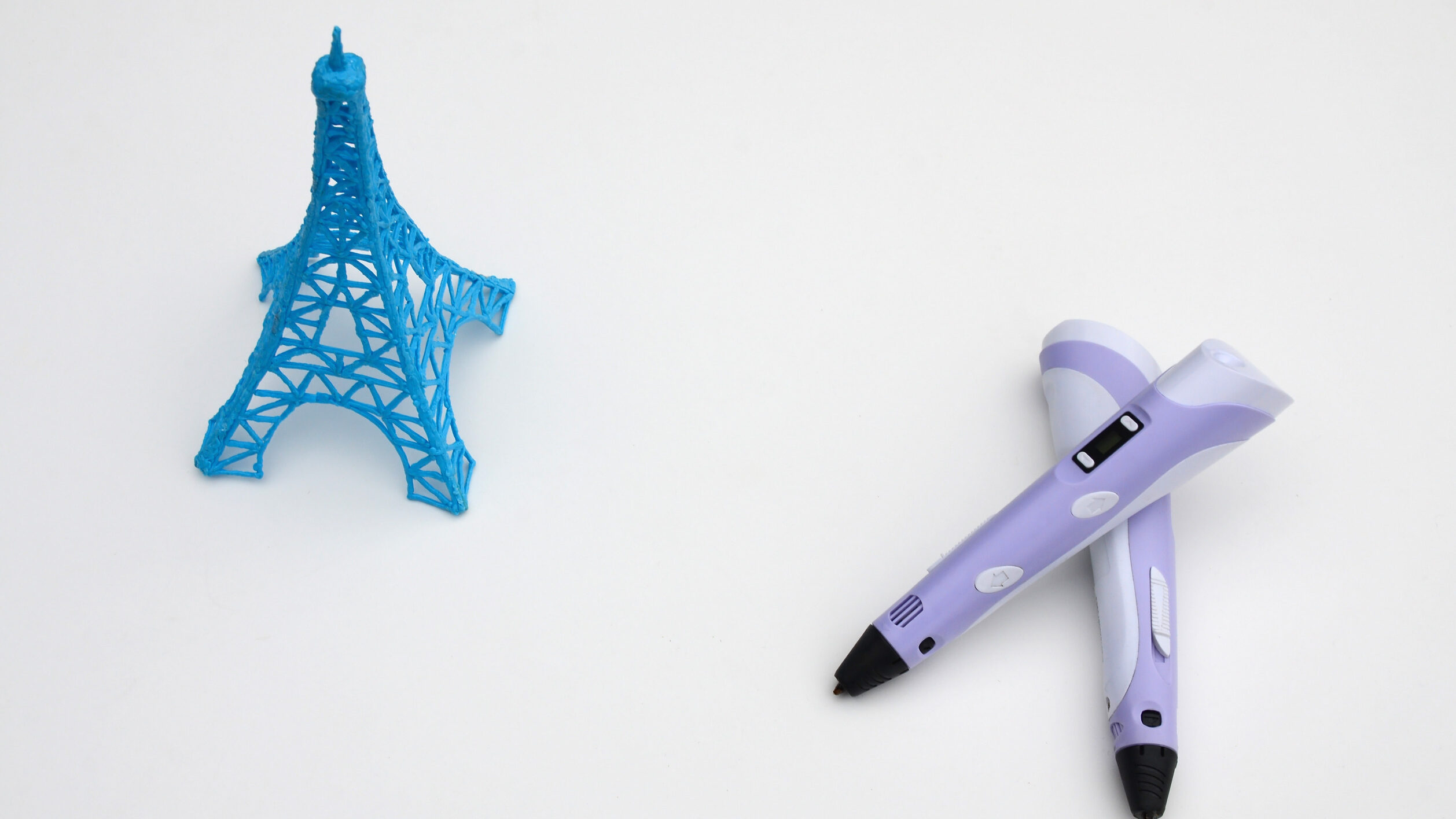
Understanding the cost of a 3D pen is essential for making an informed purchase. The price can vary widely based on several key factors, which are detailed below.
1. Brand Reputation
- Quality and Reliability: Well-known brands often command higher prices due to their reputation for quality. They are likely to use superior materials and more robust construction methods.
- Customer Support: Established brands usually provide better customer service, including assistance with troubleshooting and repairs.
- Warranties: More reputable brands tend to offer longer and more comprehensive warranties, which can add to the cost but provide peace of mind.
2. Features and Accessories
- Advanced Features: Higher-priced pens may include advanced functionalities like OLED displays for real-time temperature monitoring, adjustable temperature presets for different filament types, and precise speed control.
- Included Accessories: Some 3D pens come with additional accessories, such as extra nozzles for different types of extrusion, a variety of filament samples to start with, and carrying cases for portability and protection.
- Ease of Use: Pens with features like jam detection, automatic filament feeding, and retractable tips can be more expensive but offer a more user-friendly experience.
3. Technology Used
- Stereolithography Pens: These pens use advanced technology involving UV light to cure liquid resin. The complex mechanism and technology involved make them more expensive than filament-based pens.
- Precision and Detail: Stereolithography pens are often preferred for intricate work due to their high precision and ability to create detailed structures.
- Cost of Materials: The materials used in stereolithography, such as the specialized resin, can also be more expensive than standard filaments.
4. Material Compatibility
- Versatility: Pens that can handle a wide range of materials (like PLA, ABS, PCL, etc.) might be priced higher due to the need for a more versatile heating system and extrusion mechanism.
- Specialized Filaments: Some 3D pens are designed to work with specialized filaments, like those that change color with temperature or are biodegradable. These pens can be more expensive due to the additional engineering required.
The Best 3D Pens: A Curated List of Remarkable Options
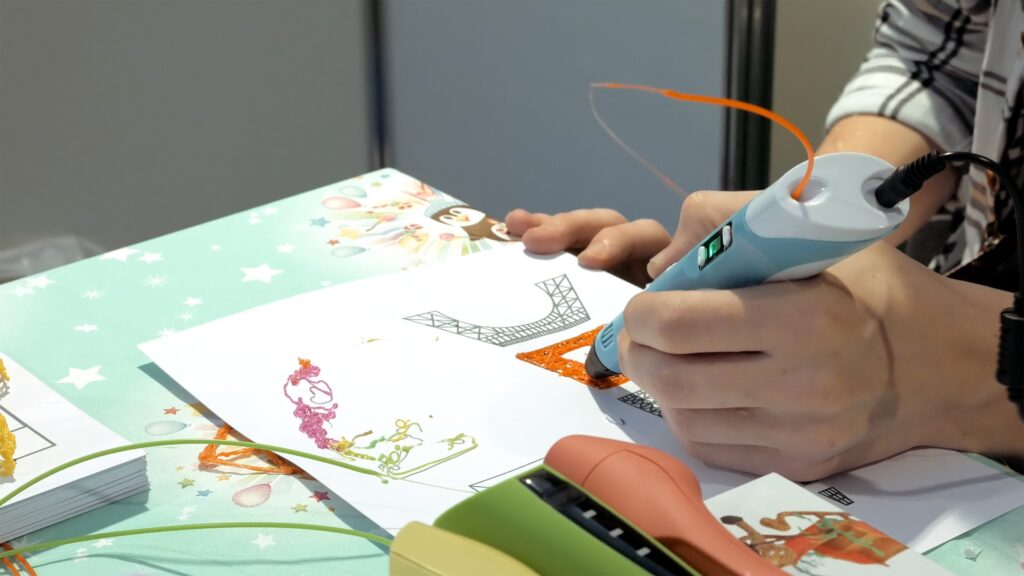
Now that we have explored the factors influencing the prices of 3D pens and discussed essential tips for buying one, let’s dive into a curated list of remarkable 3D pens available in the market today. Each pen offers its unique set of features, functionalities, and price ranges, catering to a diverse range of users and budgets.
Reviews of Popular 3D Pens
1. 3Doodler Create+ 3D Printing Pen
The 3Doodler Create+ is a sophisticated tool for teens, adults, and creators. This model stands out for its innovative ‘Dual Drive Technology’, enhancing power, durability, and overall doodling experience.
Pros:
- Comes with 15 different colors of 3Doodler Create plastic refills and a comprehensive activity guide book, making it a great starter kit.
- Compatible with various filament types (PLA, ABS, Flexy Plastic), providing versatility in creations.
- Its smooth operation and compatibility with safe, BPA-free, industrially compostable/recyclable filament make it environmentally conscious.
Cons:
- The price might be a bit high for beginners.
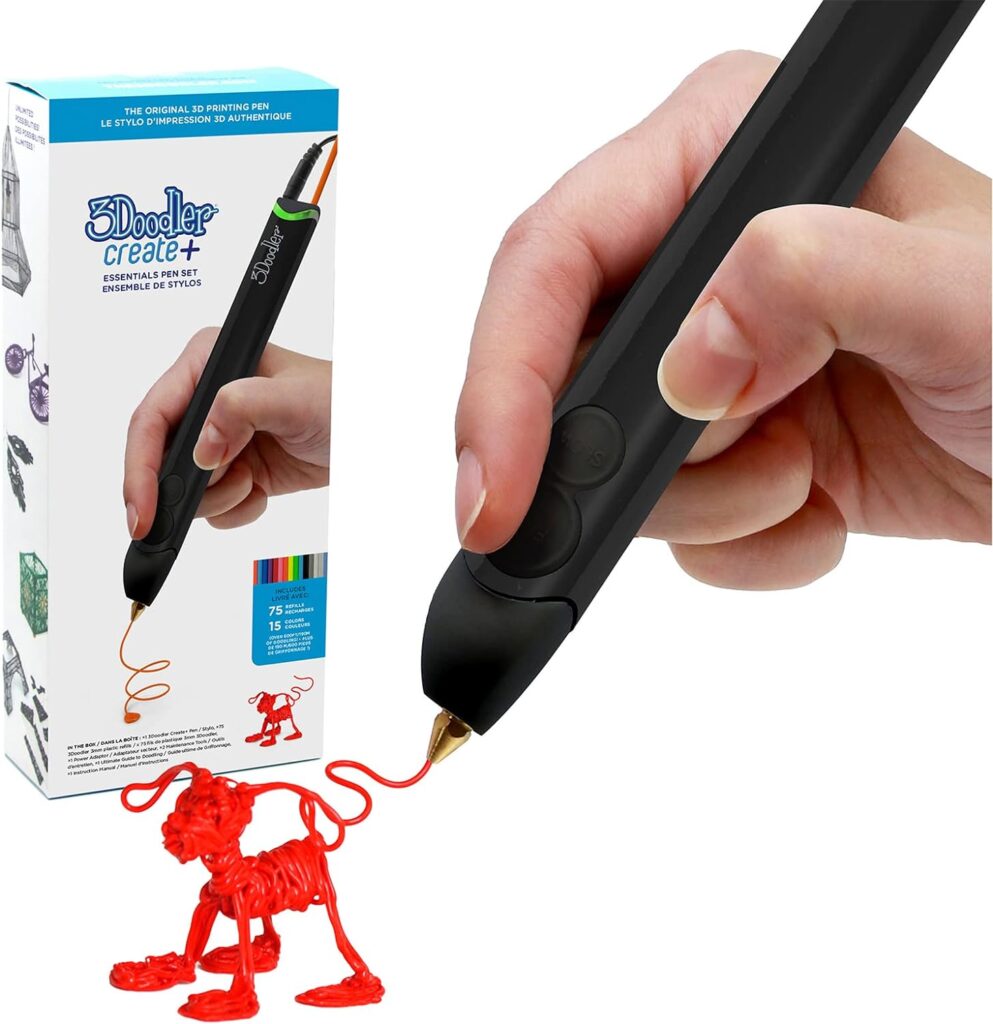
2. 3Doodler Start+ Essentials (2023) 3D Pen Set for Kids
Designed specifically for kids, this pen set prioritizes safety with no hot parts and low-risk plastics. It’s an educational STEM toy that encourages screen-free learning.

Pros:
- Kid-safe design with no burn risks.
- The upgraded model includes more plastics, stencils, and a faster charging time.
- Comes with a complete kit, including a 3D Pen, DoodlePad, and USB-C cable, making it an excellent value for money.
- Encourages creativity and learning in children.
Cons:
- Primarily suitable for younger users, may not offer the advanced features desired by older hobbyists.
3. SCRIB3D Advanced 3D Printing Pen
This pen is ideal for both novices and experienced users, offering a comfortable design and a range of features for precise 3D doodling.
Pros:
- Ergonomic design with a ‘soft touch’ surface for comfortable long-term use.
- Large LCD screen for easy monitoring of settings.
- Includes PLA plastic, power adapter, and a stencil guide for immediate use.
- Beginner-friendly with intuitive controls and built-in safety features.
Cons:
- Limited color options in the provided filament.
- May require some practice to master the different speed settings.

4. MYNT3D Super 3D Pen
A popular choice among various age groups, this pen is versatile and user-friendly, suitable for both beginners and more advanced users.

Pros:
- Stepless speed slider for optimal control.
- Ultrasonic sealed nozzle offers durability and reduces clogging.
- Compatible with both ABS and PLA filaments.
- Includes a starter kit of PLA filament and an ergonomic design.
Cons:
- Some users may prefer more filament color options included.
- The design, while ergonomic, might not fit all hand sizes comfortably.
5. SCRIB3D P1 3D Printing Pen with Display
The SCRIB3D P1 is a versatile and family-friendly 3D pen, ideal for both beginners and experienced users. It comes with an easy-to-use stepless speed function and is compatible with multiple filament types.
Pros:
- The kit includes 3 colors of PLA plastic, a power adapter, and a stencil guide, making it a ready-to-use package.
- Features like adjustable temperature and a stepless speed slider cater to a wide range of projects.
- Designed with safety in mind, it has a ceramic nozzle, premium motor, and an auto sleep function.
- Beginner-friendly with easy filament loading and an intuitive control system.
Cons:
- Limited to PLA and ABS filaments, which might not suffice for users looking for more versatility.
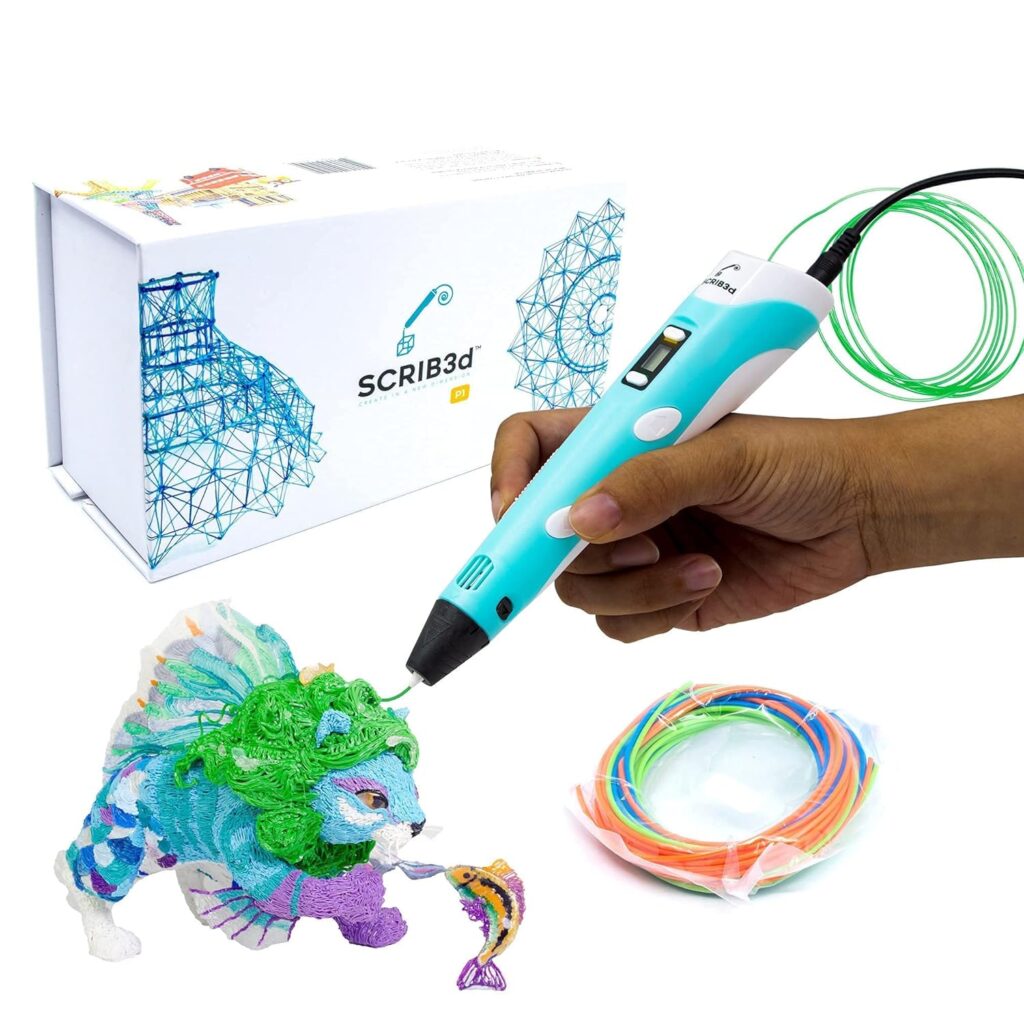
6. MYNT3D Professional Printing 3D Pen with OLED Display
This professional-grade 3D pen offers precision and control, making it ideal for artists, hobbyists, and professionals. The adjustable feed and temperature settings allow for a wide range of artistic possibilities.
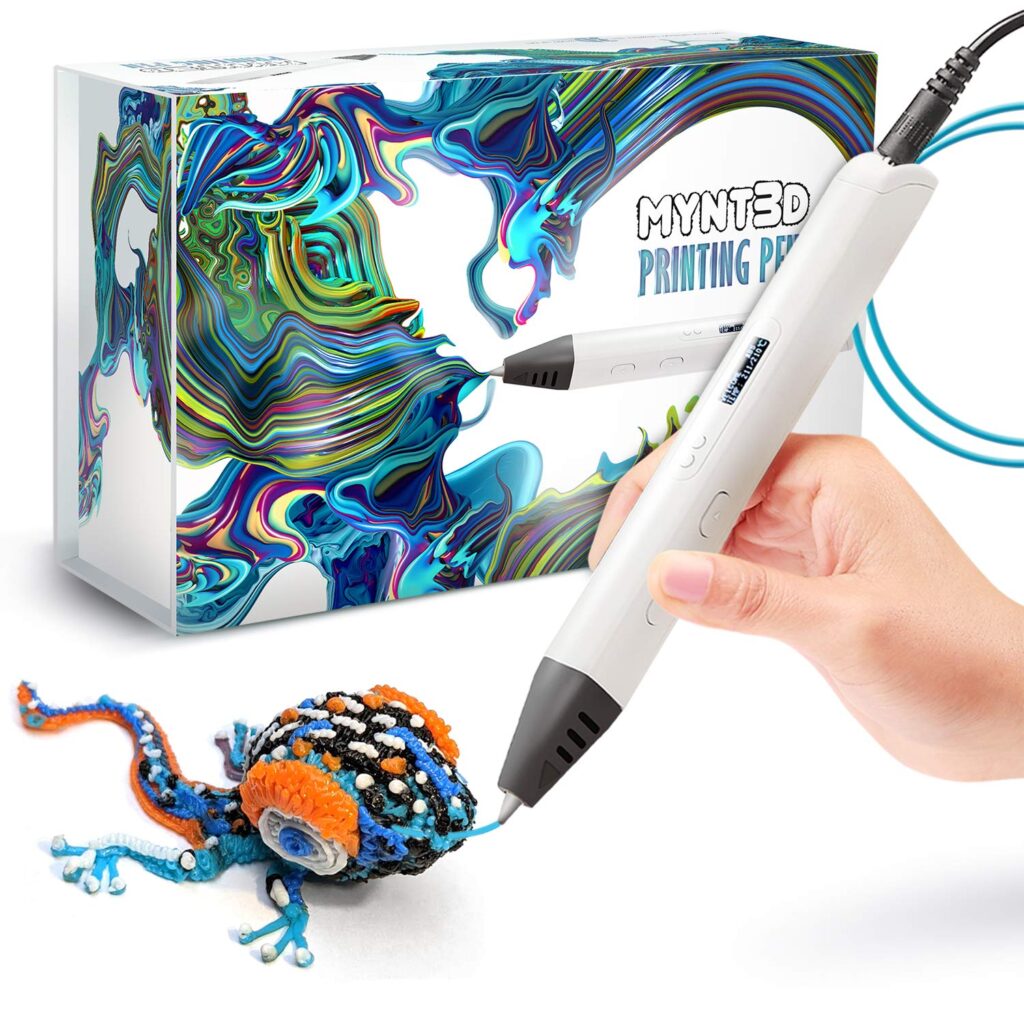
Pros:
- Temperature control in 1-degree increments allows for fine-tuning, essential for professional work.
- The OLED display provides real-time monitoring of the pen’s settings.
- Ergonomic design and included PLA filament make it suitable for immediate use.
- Known for its durability and precision, making it a favorite among professionals.
Cons:
- Higher price point, which may not be suitable for casual users or beginners.
7. 3Doodler PRO+ 3D Printing Pen (2023)
Aimed at creative professionals, the 3Doodler PRO+ is a top-tier 3D pen offering unparalleled control and versatility. It’s designed to work with a variety of materials, including specialized ones like wood, metal, and nylon.
Pros:
- Advanced features like dial-controlled temperature and speed settings for precision.
- The built-in variable fan helps in managing the cooling of different materials effectively.
- Versatile enough to handle a range of materials, ideal for prototyping and tactile design.
- Includes a comprehensive kit with various filaments and tools for professional use.
Cons:
- The high price tag makes it a significant investment, more suited for professional rather than casual use.
- Lower rating compared to other models, which might raise concerns about its performance or value for money.
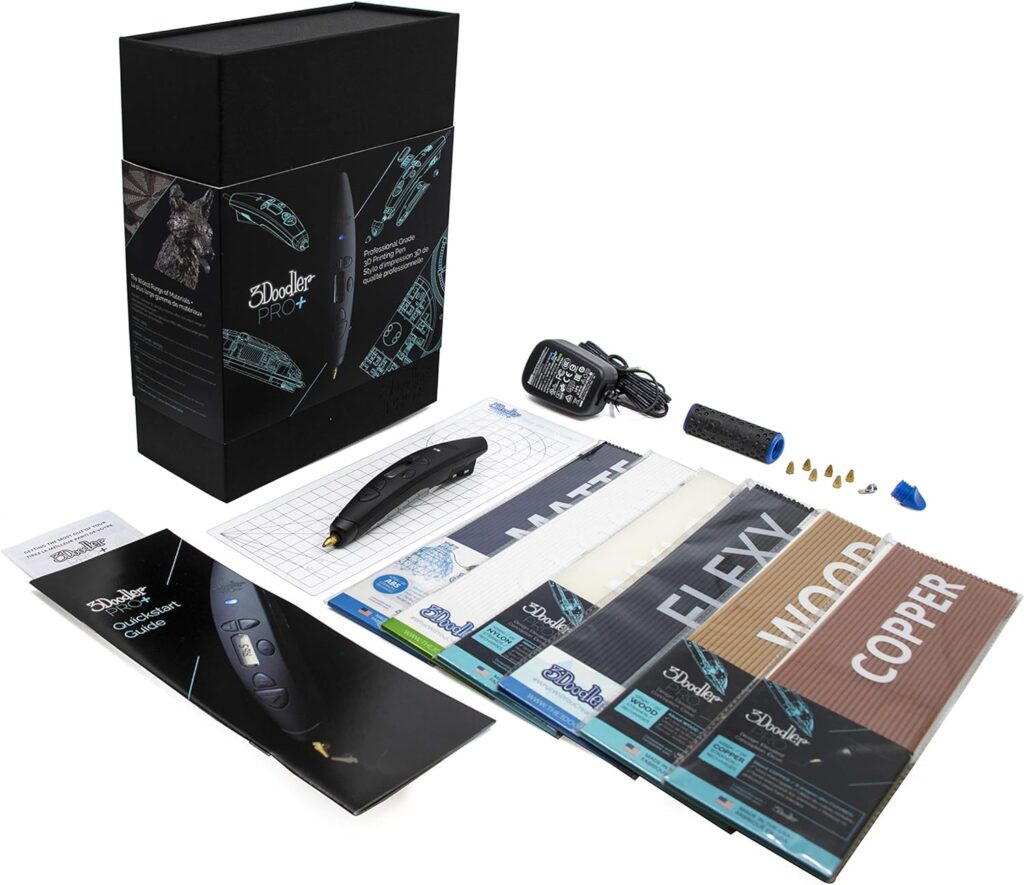
The variety of 3D pens available on the market caters to a broad spectrum of users, encompassing needs ranging from educational and recreational purposes to professional applications. Models like the child-friendly 3Doodler Start+ and the versatile MYNT3D Super Pen offer features suitable for beginners and hobbyists, while the SCRIB3D P1 and MYNT3D Professional Pen strike a balance between user-friendliness and advanced functionality. For those seeking high-end professional tools, the 3Doodler PRO+ stands out with its unparalleled versatility and control. When selecting a 3D pen, it’s important to consider your specific needs, skill level, and the type of projects you plan to undertake, ensuring that the pen you choose aligns well with your intended use.
Tips for Buying 3D Pens

Investing in a 3D pen is a fantastic way to unleash your creativity, but choosing the right one can be overwhelming. Here are some essential tips to guide you through the purchasing process.
Read Customer Reviews
- First-Hand Experiences: Customer reviews are a goldmine of information. They provide insights into the pen’s performance, durability, and ease of use.
- Pros and Cons: Pay attention to common themes in reviews, both positive and negative. This will help you understand the strengths and weaknesses of each pen.
Check Warranty and Customer Support
- Warranty Coverage: A warranty is a sign of the manufacturer’s confidence in their product. Look for pens with a comprehensive warranty.
- Customer Support: Reliable customer support is crucial. Ensure the brand offers adequate assistance for troubleshooting and repairs.
Consider Ease of Use
- User-Friendly Design: A pen with an intuitive design and comfortable grip will enhance your 3D drawing experience.
- Features: Look for features like adjustable temperature settings, speed control, and easy filament loading.
Evaluate Long-Term Costs
- Filament Refills: The cost of filament refills can add up. Consider the availability and price of the filaments compatible with the pen.
- Cost Efficiency: Some pens may be cheaper upfront but more expensive to maintain. Weigh the initial cost against ongoing expenses.
Research Filament Compatibility
- Material Types: Different pens support different filament types (PLA, ABS, etc.). Ensure your chosen pen is compatible with your preferred materials.
- Versatility: If you plan to experiment with various materials, opt for a pen that supports a wide range of filaments.
Additional Considerations
- Special Features: Some pens offer unique features like LCD displays, wireless operation, or eco-friendly materials. Determine which features align with your needs.
- Age and Skill Level: Consider the age and skill level of the user. Pens designed for children might have safety features and be easier to use, but may lack advanced functionalities.
How to Use a 3D Pen
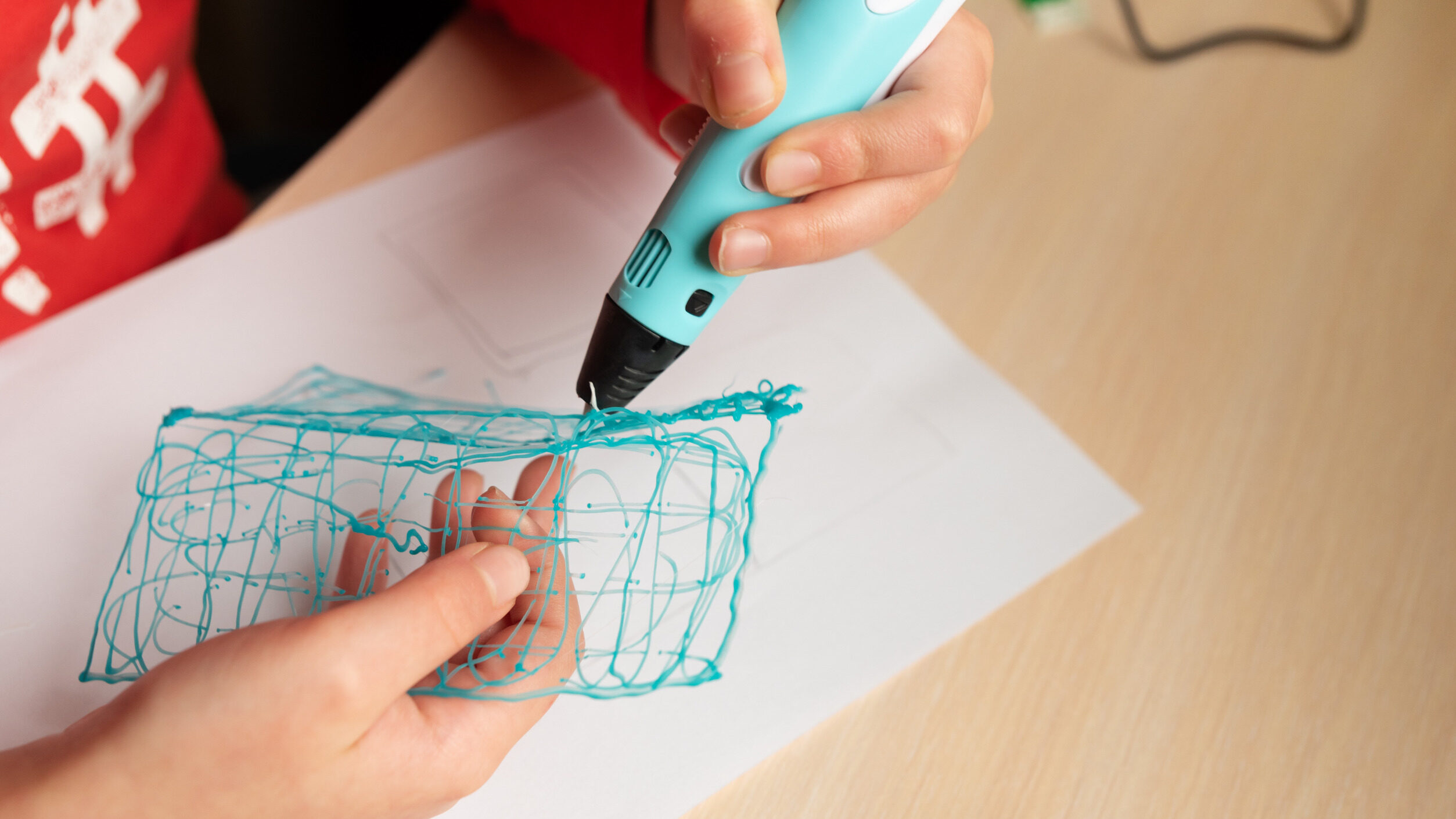
In this section, we’ll delve into the practical aspects of using a 3D pen, providing a step-by-step guide to help you start creating amazing 3D objects and artworks.
Getting Started with Your 3D Pen
- Setup: Begin by plugging in your 3D pen and allowing it to heat up to the required temperature. The heating time can vary depending on the model.
- Inserting the Filament: Once the pen is heated, insert the filament into the designated slot until it grips. Make sure you’re using the correct type of filament for your pen (such as PLA or ABS).
Drawing Techniques
- Basic Drawing: Start with simple lines and shapes. Practice holding the pen and controlling the flow of the filament.
- 3D Structures: Gradually progress to creating 3D structures. You can draw up into the air to create vertical lines, or build upon a flat surface to make more complex shapes.
- Filling and Joining: To fill larger areas, use a back-and-forth motion. For joining two pieces, slightly melt the ends with the pen before pressing them together.
Tips for Effective Use
- Speed Control: Adjust the extrusion speed according to your comfort level. Slower speeds are better for detailed work, while higher speeds can fill larger areas quickly.
- Temperature Settings: Different materials require different temperatures. PLA generally requires a lower temperature than ABS.
- Continuous Flow: For smoother lines, try to keep a consistent speed and pressure on the filament.
Advanced Techniques
- Layering: Build your creation layer by layer. Start with a base and gradually add details as you go up.
- Blending Colors: You can switch filaments to add different colors. This can be done mid-creation for blended effects.
- Texturing: Use the tip of the pen to create textures on the surface of your creation.
Safety and Maintenance
- Let the Pen Cool: Always allow the pen to cool down before storing it.
- Nozzle Care: Clean the nozzle regularly to prevent clogging. Some models come with a tool for this purpose.
- Supervision for Children: If children are using the pen, adult supervision is recommended, especially for models with hot nozzles.
Expanding Possibilities
The advent of 3D pens has opened up a world of creative and practical possibilities. These versatile tools offer unique applications across various fields, from art to engineering. Let’s explore some of the exciting ways 3D pens are being used.
Arts and Crafts
- Sculptures and Models: Create three-dimensional sculptures and models with intricate details.
- Jewelry and Decorative Items: Fashion custom jewelry, ornaments, and home decor pieces.
- Custom Designs: Bring any artistic vision to life, from abstract art to detailed replicas.
Prototyping
- Rapid Conceptualization: Quickly sketch and develop physical models of new product ideas.
- Design Refinement: Modify and refine prototypes on the fly, adding details or making adjustments.
- Cost-Effective: A more affordable option compared to traditional prototyping methods.
Educational Tool
- Interactive Learning: Enhance learning by creating 3D models that students can interact with.
- STEM Education: Ideal for teaching science, technology, engineering, and mathematics concepts.
- Creativity and Problem-Solving: Encourage students to think creatively and develop problem-solving skills.
Repair and Modification
- DIY Repairs: Fix broken parts of various objects, from toys to household items.
- Custom Modifications: Personalize or modify existing items to suit individual needs or preferences.
- Resourceful Solutions: Provide an innovative way to extend the life of objects, promoting sustainability.
Fashion and Design
- Unique Accessories: Design one-of-a-kind fashion accessories like necklaces, bracelets, and headpieces.
- Textile Innovation: Experiment with 3D pens on fabrics to create unique patterns and textures.
- Avant-Garde Creations: Push the boundaries of fashion design with futuristic and innovative designs.
Conclusion
The versatility of 3D pens makes them a powerful tool for artists, designers, educators, and hobbyists. Whether it’s creating stunning art pieces, developing prototypes, facilitating interactive learning, conducting repairs, or innovating in fashion, the possibilities are nearly limitless. Embracing the capabilities of 3D pens can lead to remarkable creations and breakthroughs in various domains, showcasing the fusion of technology and creativity.
FAQs (Frequently Asked Questions)
- Can I use any type of filament with a 3D pen?
Not all 3D pens support every type of filament. Check the manufacturer’s specifications to ensure compatibility with the filament you intend to use. - Are 3D pens suitable for children?
Yes, there are 3D pens designed specifically for young users. However, adult supervision is recommended, especially for younger children. - How long does a 3D pen filament last?
The filament usage depends on the complexity and size of your creations. A rough estimate is that 1 meter of filament can create approximately 10 minutes of continuous drawing. - Can I change the nozzle of a 3D pen?
Not all 3D pens have interchangeable nozzles. Check the product specifications to determine if the pen you’re interested in offers this feature. - Are 3D pens limited to plastic materials?
While most 3D pens use plastic filaments, there are specialized pens that can work with materials like wood, metal, or conductive filaments. These pens are usually more expensive and require specific expertise.
Enjoy your 3D pen journey and let your imagination soar!
Additional Resources
- Sciencedirect – Instrument-free fabrication of microfluidic paper-based analytical devices through 3D pen drawing
- Springer Link – A study on the design education method using 3D pen in an era of manufacturing change
- https://youtu.be/rzmih_dFi3Y?si=XFHiM5DlbqmJoQe9
- https://learn.the3doodler.com/about/how-to-draw-with-a-3d-pen/



